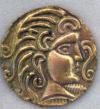The Magical Reindeer Nose

Reindeer live in harsh conditions during the winter. In Svalbard and on the fells and mountains of mainland Norway, temperatures sometimes drop to 30-40 degrees Celsius below zero. Little food is to be found when snow covers the landscape, and reindeer have to chew cold snow to get water. So how do the reindeer survive when it’s so very cold?
The reindeer nose has a very large internal surface area, which allows it to warm cold air in record time. How is this possible? What’s nature’s secret recipe?
What is it with Rudolph’s nose?
Does Rudolph’s nasal structure explain why reindeer do so well in cold climates?
This hypothesis interested PhD student Elisa Magnanelli and her supervisors at the Norwegian University of Science and Technology, Professor Signe Kjelstrup and Øivind Wilhelmsen. Wilhelmsen is an adjunct professor and researcher at SINTEF Energy Research. Their disciplines are thermodynamics and mass and heat exchange. But why would engineers be curious about animal respiratory systems? That will soon become clear.
Reindeer on treadmills
Magnanelli and her supervisors work closely with scientists at UiT—The Arctic University of Norway in Tromsø. The Tromsø researchers have brought real reindeer into a climate chamber and had them walk on a treadmill to study their respiration – all in the service of science. Measurements show that reindeer have a fantastic ability to change the temperature of the air they inhale before it reaches their lungs, and vice versa. If the outside air temperature is 40 degrees C below zero, the temperature when the air reaches the reindeer’s lungs is about 38 degrees C.
That means the reindeer’s ingenious nasal structure can change the temperature of the air an incredible 70-80 degrees in less than one second. On exhaling, the reindeer cools its warm breath instantly, in order to conserve as much body heat as possible.
In addition, the reindeer breathes out minimal moisture when it exhales – which is especially important when their only access to water is snow, and icy snow at that.
Huge inner surface area
The powerful reindeer snout is made up of cartilage and bone, fleshy structure, mucous membranes and lots of blood vessels. Researchers at UiT have taken internal measurements of the nose and done CT scans of reindeer nose slices. In this way, the researchers were able to acquire cross-sectional images of the reindeer’s breathing organ along its entire length. The pictures show that the nose interior has an unusual and strange structure that resembles a seashell.
Researchers also measured the inner surface area, which turned out to be enormous. Enormous in what way? Think of the Norwegian coast. If you measure the actual length of the coast, including all the nooks and crannies, you will find that the coastline is enormously long. This is what the inner surface of the reindeer’s nose is like as well. The expansive inner surface provides plenty of space for exchanging heat and water vapour between the air and the nasal wall.
What is nature’s recipe?
The reindeer’s incredible ability to warm the air it breathes and control the humidity is an exciting topic for the NTNU researchers, who study thermodynamics and heat exchange.
Professor Kjelstrup and her colleagues have spent years studying energy-efficient systems. She began to speculate about whether nature itself could teach us something about energy efficiency, and contacted the Tromsø researcher Arnoldus Schytte Blix, who told her about the reindeer research.
Mathematical reindeer nose
The researchers decided to create a mathematical model of a reindeer’s nose. Magnanelli was assigned the task. She obtained several vital measurements from other research groups, including the researchers in Tromsø. These measurements included the amount of air a reindeer inhales when it breathes, blood flow rates and temperatures in different parts of the nose and the moisture content in the reindeer’s breath. The data were used both to develop and assess the accuracy of a computer program specially designed to simulate a reindeer’s nose.
The illustration shows cross-sections of a reindeer nose. It clearly shows the complex structure of the nose, which looks like the cross section of a seashell.
Data noses in the lab
In addition to creating a data-simulated reindeer nose, the scientists created a computer program of a simplified cylinder-like data nose that served as a reference case.
The researchers conducted repeated experiments in both data noses, with surprising findings.
One finding showed that Rudolph’s nose can very nearly be explained by the well-known theoretical principle of constant entropy production. The term could confuse the most avid lay reader without a quick explanation– but consider this: When you go ice skating, you use some of your energy to overcome the friction that occurs between the ice and the skates. The friction generates heat under the skate blades, which uses energy. This is an example of the second law of thermodynamics.
But no real process is one hundred per cent energy efficient. There is always some friction, which dissipates as heat into the surroundings. If you live in Svalbard or on Norway’s frigid Røros plateau, it’s important to lose the least amount of energy into the surroundings. Reindeer have clearly figured this out.
The ingenious reindeer nose
Magnanelli’s simulation experiments, carried out 1600 kilometres and 15 degrees of latitude away from the reindeer’s northernmost stomping grounds, shows that the nose mostly works according to the principle of minimum energy loss. This energy dissipation in the form of friction is what scientists call entropy production. The brilliant reindeer nose ensures that entropy production is almost always uniform. This means that the animal as a whole loses the least possible amount of energy to the environment when it breathes. The reindeer nose roughly follows the mathematical “constant entropy production” equation.
To explain why this is so beneficial, consider the skating example. To use the least amount of energy to get around an ice rink, it’s best to maintain a steady speed. The same is true of reindeer noses – they’re designed to have close-to-uniform entropy production.
The colder the weather, the more effective the nose
The second finding that surprised the researchers is that the colder the air, the more energy efficient a reindeer nose is compared to a nose without the seashell shape. At 30 degrees Celsius below zero, the reindeer’s seashell-shaped nose works even better than at 10 degrees below zero.
Between the mathematical nose model and the close-to-constant entropy production finding, NTNU engineers are now better able to explain how a reindeer’s nose works. The cold air is drawn in through the nostrils, passing over the large inner surface. This surface consists of nasal mucus, located outside the fleshy nose structure and with many small blood vessels. The warm blood instantly and continuously heats up the mucus, which in turn heats the air being inhaled.
Reindeer need to retain the water or moisture exhaled from the lungs so they don’t need to eat snow. And this illustrates another brilliant feature of nature: Winter air is cold and dry. In order for the heated air not to be too dry when it reaches the lungs, a little moisture is emitted from the mucous membranes into the air when the reindeer inhales. When the air is exhaled, the mucous membranes recover the moisture, so the reindeer exhales dry and partially cooled air.
Using knowledge of nature for society
There are many reasons why scientists and engineers are eager to understand how a reindeer’s nose actually works. Reindeer noses serve as excellent heat and vapour exchangers because of the complicated seashell-like shape.
In fact, it’s entirely possible that this newly acquired knowledge may one day come in handy when industrial designers need to create balanced ventilation systems for homes and cottages in extremely cold climates.. The new knowledge may make an important contribution in building net-zero homes in the Arctic.
In fact, it would probably be a perfect project for Santa’s workshop at the North Pole.
Contacts and sources:
The Norwegian University of Science and Technology (NTNU)
Citation: lisa Magnanelli, Øivind Wilhelmsen, Mario Acquarone, Lars P. Folkow, Signe Kjelstrup. The Nasal Geometry of the Reindeer Nose Gives Energy-efficient Respiration. Journal of Non-Equilibrium Thermodynamics. DOI: https://doi.org/10.1515/jnet-2016-0038, July 2016
http://geminiresearchnews.com/2016/12/magical-reindeer-nose/
Source:
Anyone can join.
Anyone can contribute.
Anyone can become informed about their world.
"United We Stand" Click Here To Create Your Personal Citizen Journalist Account Today, Be Sure To Invite Your Friends.
Before It’s News® is a community of individuals who report on what’s going on around them, from all around the world. Anyone can join. Anyone can contribute. Anyone can become informed about their world. "United We Stand" Click Here To Create Your Personal Citizen Journalist Account Today, Be Sure To Invite Your Friends.
LION'S MANE PRODUCT
Try Our Lion’s Mane WHOLE MIND Nootropic Blend 60 Capsules
Mushrooms are having a moment. One fabulous fungus in particular, lion’s mane, may help improve memory, depression and anxiety symptoms. They are also an excellent source of nutrients that show promise as a therapy for dementia, and other neurodegenerative diseases. If you’re living with anxiety or depression, you may be curious about all the therapy options out there — including the natural ones.Our Lion’s Mane WHOLE MIND Nootropic Blend has been formulated to utilize the potency of Lion’s mane but also include the benefits of four other Highly Beneficial Mushrooms. Synergistically, they work together to Build your health through improving cognitive function and immunity regardless of your age. Our Nootropic not only improves your Cognitive Function and Activates your Immune System, but it benefits growth of Essential Gut Flora, further enhancing your Vitality.
Our Formula includes: Lion’s Mane Mushrooms which Increase Brain Power through nerve growth, lessen anxiety, reduce depression, and improve concentration. Its an excellent adaptogen, promotes sleep and improves immunity. Shiitake Mushrooms which Fight cancer cells and infectious disease, boost the immune system, promotes brain function, and serves as a source of B vitamins. Maitake Mushrooms which regulate blood sugar levels of diabetics, reduce hypertension and boosts the immune system. Reishi Mushrooms which Fight inflammation, liver disease, fatigue, tumor growth and cancer. They Improve skin disorders and soothes digestive problems, stomach ulcers and leaky gut syndrome. Chaga Mushrooms which have anti-aging effects, boost immune function, improve stamina and athletic performance, even act as a natural aphrodisiac, fighting diabetes and improving liver function. Try Our Lion’s Mane WHOLE MIND Nootropic Blend 60 Capsules Today. Be 100% Satisfied or Receive a Full Money Back Guarantee. Order Yours Today by Following This Link.






